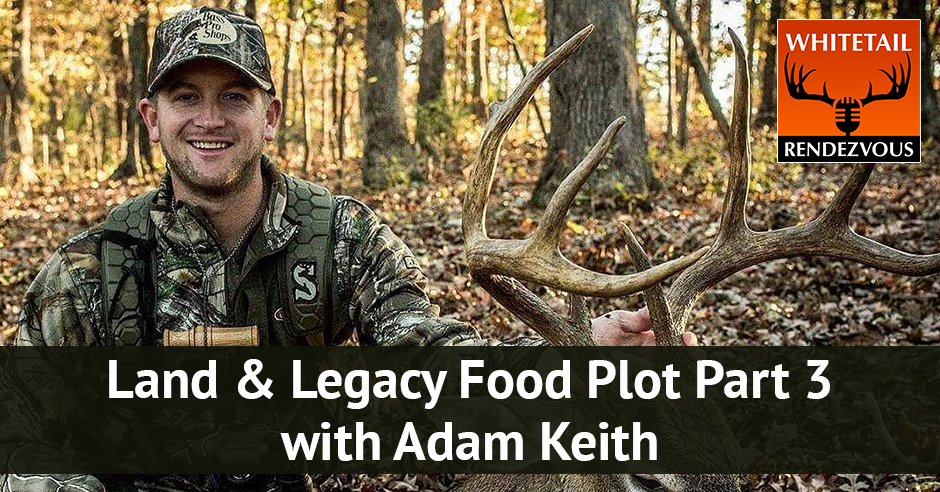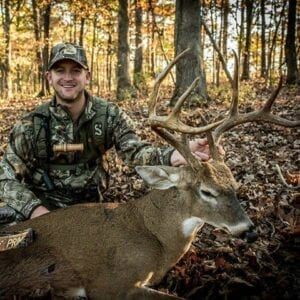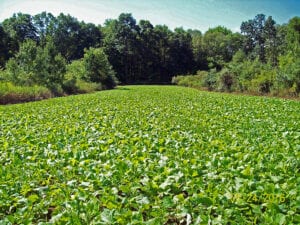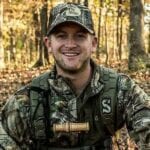
Wrapping up the Land & Legacy Food Plot series, Adam Keith graces the show one last time to talk about getting you started on the food plot chain of events. He takes us to building food plots 365, letting us in on what to plant in certain months and how they can be offered to the deer. He also gives insights on transition or kill plots, predator control, and adding diversity. Learn more about land management and the ways you could improve the land amidst its history of continued destruction in this final episode of the series.
—
Listen to the podcast here:
Land & Legacy Food Plot Part 3 with Adam Keith
We’re wrapping up with Adam Keith from Land & Legacy. We’ve been talking about food plots and a few other things. This is going to be on food plots because if you’re going to start the food part chain of events, you’ve got to be all in. Don’t plan a kill plot and say that’s good enough, you disappear, and think that’s going to help you land. You might kill a deer. It’s not going to help your land.

It’s one of those things where let’s boil it down to the root of this of saying, “Here’s my best pitch for you of why should you plant a food plot,” or you’re weighing that out in your head and you say, “How much money are you willing to spend? Because to have a successful food plot, one that’s beneficial and your work is rewarded, it’s going to take this amount of dollars.” If they’re like, “I don’t know if I’ve set aside that much,” we can take what you do have set aside and do something probably as beneficial.
We’ve been talking about the land management plan. Sometimes the native browse, Forbes and everything you have on your property enhances it and that will be bettering the food plot. Don’t yell at me X, Y, Z companies are saying that, but that’s the truth.
When did food plots originate? Maybe it was many years ago. What were the deer surviving on before that? Let’s go back before we introduced things like alfalfa and soybeans and say, “Deer were doing fine before we settled America.” They were here, it wasn’t like we introduced them, and we had to provide food plots so they could survive. They were doing fine without us. How do we replicate what was going on during that time frame and use food plots to our advantage? For us, if we replicate nature pre-settlement and what was going on before we moved in, a lot of the things that were there, you look at it, great plains come to mind. There was diversity. It wasn’t native grass. It was all kinds of wildflowers and forbes. There were tons of food. We had approximately 75 million buffalo living here in North America. That’s a lot of forage to have to feed the buffalo. There was an estimated about fifteen million elks. There was all the whitetail deer.
There were plenty of food available without any food plots, but the problem is now we don’t have that same type of habitat. Replicating that habitat by a lot of prescribed fire, opening up the canopy and getting back to woodlands and savannas to where you have this undergrowth, managed with prescribed fire to where you have food available year-round. You can add the food plots on top of that. For us, food plots come in as a hunting destination or a way to pattern deer. Maybe you’re not hunting on the podcast, this was the first segment, maybe you’re hunting off of it, but you still have a more consistent pattern of deer going to and from and a specific area.

All through this whole series, I’ve been talking about transition plots, I call them kill plots because I want that buck to stop, I want that doe to stop. Between bedding and where they’re going to feed, I want them to stop. They do that anyway. Here’s one thing I would challenge everybody to do now. Go out to your favorite place, play the wind as if you’re going to hunt. Leave your bow at home, take your camera. Watch how deer move through the woods. You’re not going to kill them. You’re going to sit there and watch. Watch how they move because, unless chased, they don’t gallop or run through the woods. They mosey and they slip their toe underneath the leaves. They do this and they munch here. That’s what they do. Many times, we don’t get that. My idea of small food plots is simply you’re going to get them to come along their trail in a little opening or whatever. They’re going to stop for a munch. If everything works out right, you might get a shot, you might not.
An analogy we used with a lot of our consultant clients was when you’re hunting those little small food plots, they’re not destination food plots to where deer aren’t going to come in an hour before dark and stand in it all night long. They’re going to come in an hour or half-hour or twenty minutes before dark, they’re going to grab a few bites. They’re going to stop and take a few bites, but they’re going to keep on walking and get where they’re going. You’re hunting an animal in their hallway rather than hunting them in the kitchen. The problem with hunting them in their kitchen or destination area is they’re standing in that food plot when you have to climb down and get out of there, so there’s a better chance or a high-risk of spooking them. If you hunt them in the hallway, they’re passing through. You see them, you can shoot them or not, or pass them, take photos. They’re going on about their business and you’re walking out. They never know you’re in the world.
Food plots come in as a hunting destination or a way to pattern deer. Share on XBucks do have staging areas. We’re not going to get into that. That’s hunting techniques. 365, in January, what the heck do I want to make sure is on the ground or available for my deer? They come out of the rut. The does are bred. A lot of things are going on. Everybody is stressed. It was a tough New Year’s Eve.
From a native standpoint, the natural food available, you want to make sure you have young forests, some browse available. That could be in the form of young sprouts, young trees growing. There are little buds everywhere. Maybe you want to go out, this is a technique we use during January of going out and cutting some trees down that have already started budding or forming buds, so dogwoods come to mind, hickories come to mind, some oaks. They’ve already started. Even sassafras started putting on little-bitty buds to where that’s a great food source, but chances are it’s too high for the deer to reach. You cut those trees down, now you’ve made it available. If it’s still hunting season, you can hang a stand. Cut the trees, go in there and hunt it that afternoon or next day and probably catch deer coming in there to feed on that. During January, February you want to make sure you have plenty of browse available. That’s not the form of forbs and things like that, it’s probably more in the form of young forest.
In the fall is the peak time that the leaves got the most energy, food source nutrition. That’s what we’re always looking for nutrition that they’re going to have all year. You’d never know that and you can see them eating the leaves. I learned this from a guy hunting in the book of mountains and he said, “We’re going to hunt this because the leaves are coming in and everything. They’ll be coming through like vacuum cleaners.” That’s what he said. He was right. There wasn’t a herd. It was one or two. They knew where the food was. Moseying on through and munching here and munching there. They knew where the food was at that right time. January, we got that. February, we got similar things and March is a tough time.
In that period of before spring green-up and it’s the very end of the growing basically the whole year. Everything’s been eaten year-round and food is very limited. We’re now waiting on spring green-up so we can get some new growth. Let’s talk about January, February, March from a food plot standpoint. You want something that’s high energy. If you want to plant something that’s going to be great during those months, it’s some carbohydrate in the form of probably a soybean plot or corn. Another thing you could play to get some food available that time of year would be turnips. They’re probably eating the balls of the turnips at that point. The one thing I liked to plant for that February, March would be winter wheat, true kale or oats, something that can take the forage. It’s going to be one of the first things to start greening up in the spring.
I’m trying to think because winter wheat, that’s what it does.
It brings up quicker than a lot of food plots. You think about winter wheat and you plant one seed and it grows up in a stem one little thing. It gets eaten. You get four or five stems. It gets eaten and it starts clumping up. That was the wonderful thing about it. That’s why you see cattle farmers turn or see guys turned cows on wheat fields is so they can get more growth. Even with snow geese, deer and the amount of traffic of cows, you can hardly eat it to where it goes away. It keeps coming back. February, March, there’s usually some growth coming in there.
In April, May, June, we see fawns drop. I’m going to throw this in because I’ve been thinking about it. If you’re not predator hunting your land, get somebody who wants to go out and kill some coyotes. If you can hunt where bears are, bears and coyotes and wolves. We’ve got from one of the farms that I hunt in Wisconsin. Unbelievable thrill camera shot of a wolf with a fawn in his mouth going by. Did it weigh twenty pounds? It doesn’t matter. She’s going to feed her pups. Predator control is so critical. You can feed them, but if they get impounded by the predators, you’re not helping. This goes back into the whole land management thing. You’ve got to spend time. The other thing is when the coyote pup is involved, they’ve never been shot out. They don’t know where humans are, you can dupe them easily. What are your thoughts on that? I know we’re off track a little bit.
Removing the predators so much to where the deer just thrive is not healthy either. Share on XI look at predator control with a couple of different ideas than a lot of other people. The coyote is native to where it’s always been here. There are a lot of great interviews with a guy talking about coyotes and the one species that we’ve almost tried to kill out completely, but we never could. The only thing we did was caused the population to grow even more. When you think about predators too, though, it’s great if you can trap and hunt them. Chances are a lot of guys don’t have that capability to do that on their farm day in and day out where they leave a big impact. Think about it from adding more, when you look at the diets of those predators, specifically the coyote, what is his diet a lot of? They’re rabbits, rats, mice, moles, some birds and quail. You step up the food chain. There are turkeys and fawns. If we can add more of those other species that might take the pressure off of the fawns.
When you look at the populations of cottontail rabbit, they’ve dropped a lot because of that lack of habitat. The quail, the grouse have all dropped because we’ve lost the habitat that they need that early secession, native grasses, the high diversity of all kinds of that. We don’t have that habitat much anymore. We farm from ditch row to dish row. If we added that habitat, we would have more rabbits. We’d have more rats. We’d have more quail. We’d have more food available to where maybe they might not be eating as many fawns and turkeys. They would be eating those animals instead. You look at the birth rate of rabbits, they may have a couple of litters every single year with a lot of them where a doe is only going to have one or two, maybe three. Let’s try it. I look at it and try to take the pressure off them by improving the habitat.
Trapping is the lowest in America because a lot of people, especially out here in Colorado was there when we lost legal traps. I was there when they prepare in the springtime. I was at the commission hearings. It’s all a balance. That’s the thing that we don’t know. I like what you said because it is a balance if we enhance the habitat where all these critters are living to its carrying capacity. I don’t want 100 deer on our farm.
I see that a lot where people hunt for deer and they let the population get out of control because they like seeing deer, but that’s not the way God intended it to be. You removed the predators so much to where the deer just thrive. That’s not healthy either.
Eddie, in our pre-hunt get-together says, “I got too much corn get knocked down.” A farmer lives by his yield bushel per acre, that’s what he lives and dies by. We’ve already talked about it you got to put in a lot of stuff, it’s 100-year farm. He’s got a lot of inputs to get the output. You got commodity prices. The farm is a crapshoot. You think about that. He says, “If you got a tag, use it.” We got tagged as many do as you see because we’re going to eat every single of those does are gone. The reasons were empty. He tells us that. It’s sometimes hard for people to see. Who cares? You got to go with the farmer. You got to go with that balance because the land will tell you what it needs. That’s what I’m trying to say right now. The land will tell exactly what it needs, it’s up to you to read the signs.
It’s a whole lot easier at work with nature than against it. I haven’t even used this word, which is surprising to me. When you look at the land and how you can improve it, one of the biggest things you can do is think of one word, diversity. We were talking to food plots and two minutes later, we’re not even close to it. Adding diversity can be key. Adding young forest so you have plenty of browse, adding early successional habitat as far as ragweed, pope berry and some native grasses. Food plots on top of that and young shrubby species, as well as oaks and other types, all those mixed together is probably going to do a whole lot better than you try to plan a one-acre food plot. That’s funny how that works. We always say we can’t do better than the way it was designed. All we can do is try and replicate the way it was designed. Adding diversity, managing it with the natural, hyper management that was used in our area, prescribed fire and grazing. Try to replicate that as key to having the most productive land that we can.
Back to thinking about not killing, it’s been Theodore Roosevelt. You can go on and on. There are some iconic people I didn’t even use their name. When you think about it, the Native Americans had it figured because they moved with the buffalo. The buffalo would eat 1,000 acres here and no more food and they leave, but they fertilized it. They turned it over because they had their dust-ups or whatever they call them, their dusting bowls and all that. The elk were plains animals. Most people know that, but that’s what they were. The grizzly bears are plains animals because that’s where the food was. Think 75 million buffalo, the wolves, and that was their symbiotic relationship with the whole earth because the calf and the weak stuff, they got deceased, they were lunch.
If you want to become a better hunter, get into your land. Share on XIt’s the survival of the fittest. That rotation of the buffalo, to me that’s one of the craziest things is when you think about how huge the herds were of buffalo, thousands and thousands of them moving around. They would basically eat a third and trampled two-thirds of the plant. The number of foods, the weight of them almost and pushing that biomass into the soil, but leaving the manure, the urine, the saliva, the snot and all the bacteria that they would leave behind, which fed the insects. They would then break down the manure into the soil. The key component was they didn’t return to eat there because there’s so much manure. They gave it time for everything to rest and grow back. I nerd out over that one. That’s definitely something that is amazing to me what went on.
We’re literally off the reservation. When you think about that and that’s a perfect example. I’ve been to the buffalo jumps. The buffalo jump, the Indians, there’s nothing. They use sticks and stones and herded the buffaloes to these cliffs and jumped them off the cliff. At the bottom, everybody in the village would slit throats and process the meat. I love what Adam said because if you study it, it was amazing how they could support that many animals, 75 million of anything is a lot. They would travel. The Indians would follow them. The wolves would follow them. It all worked. We came and we messed it up.
It’s depressing what we did. When you think about the Native American with the buffalo, even though they did that, they would drive them off the bluff. One thing they still did was respect the animal and have that spiritual type connection with the animal. That’s something to me that I feel like we don’t do anything near what they did. They had this almost admiration and respect to the animal even though they were killing it.
That was their life. I was fortunate to be up in the hunt with the Inuits up north. I was sitting with an elder and I said, “How’d you keep doing it?” The Inuits have been there a long time. They came across the land bridge, if you don’t know where that is, Google it and do some reading. He said that it was simple. The caribou came, we live. It didn’t come, we die. That was it. They use every single part of that animal. Nothing was wasted. I was amazed, the simplicity of life, the hardness of life. If you’ve ever been up in the Arctic, you know how hard it is. It’s for a few months. It’s fun to be there at the rest of the time. I don’t want to be there. Diversity and we’re part of that. If you want to become a better hunter, get into your land.
We talked about the ten-year plan, that’s all I can say. Let’s manage it for my lifetime and do such a good job with managing it that I inspire the next generation to do the same thing and keep on managing it. We’re doing nothing but improving the land and not repeat the history of destroying the land while we were here. The next generation messes it up even a little bit more. At some point, that’s got to come to an end. Let’s go ahead and work on improving it.
How do people get a hold of you, Adam Keith?
They can reach out on Land & Legacy Instagram or Facebook or get on the website, www.LandAndLegacy.tv and shoot us an email right there. Ask us a question and follow along on the podcast.
Important Links:
- Land & Legacy
- Instagram – Land & Legacy
- Facebook – Land & Legacy
- www.LandAndLegacy.tv
About Adam Keith
 Born and raised in Southwest Missouri, this local calls the Ozark Mountains home. This drives his passion to make home a better place for future generations.
Born and raised in Southwest Missouri, this local calls the Ozark Mountains home. This drives his passion to make home a better place for future generations.
From a young age, Adam knew his calling was to leave things better than he found it and share God’s Creation with others!
